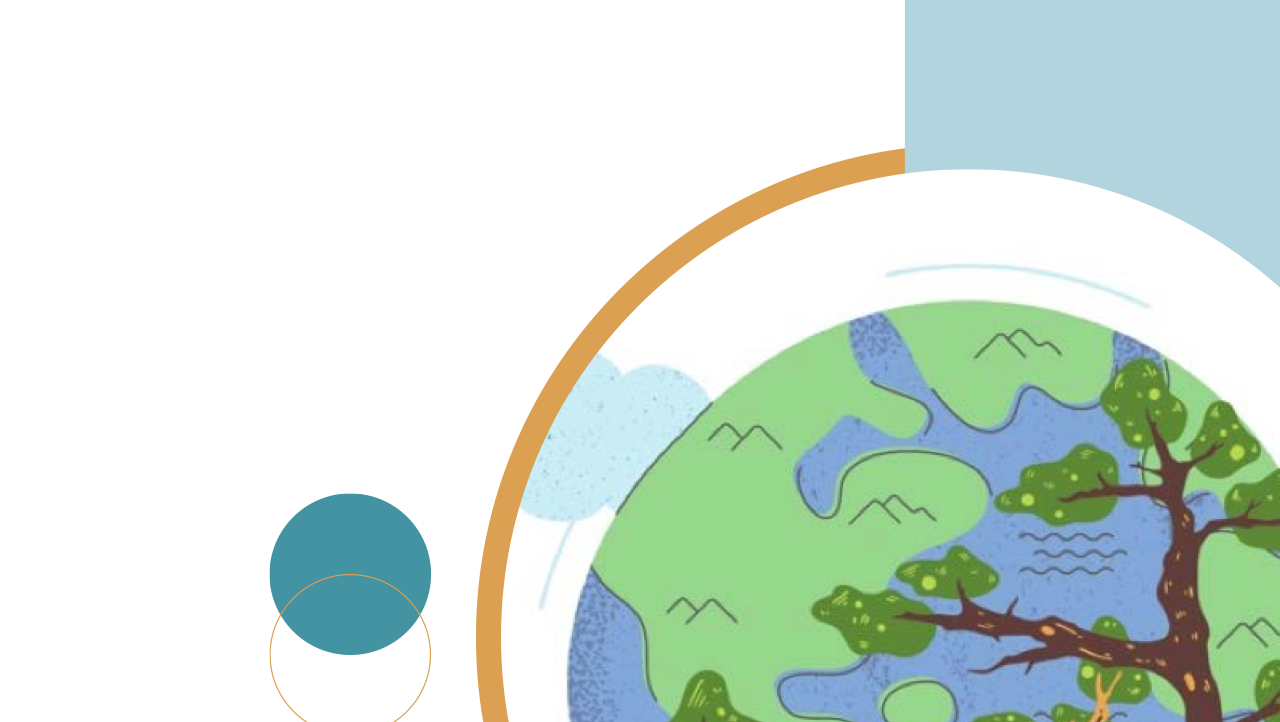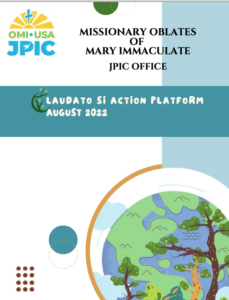News Archives » Issues
VIDEO: JPIC’s Laudato Si’ Action Platform Report September 16th, 2022
Caring for our common home is essential to Missionary Oblate’s mission to the poor, because they are the ones most affected by the devastation to the planet.
The seven-year Laudato Si’ Action Platform offers a fresh opportunity for each of us to commit to complete sustainability in the spirit of Laudato Si. Oblates JPIC is promoting the following works from Oblates and allies in the province as a step toward integral ecology.
In the Spirit of Laudato Si: Missionary Oblates Connect Communities with the Environment September 7th, 2022

In his encyclical Laudato Si’– On Care for Our Common Home (2015), Pope Francis wrote, “Whether believers or not, we are agreed today that the earth is essentially a shared inheritance, whose fruits are meant to benefit everyone. For believers, this becomes a question of fidelity to the Creator, since God created the world for everyone. Hence, every ecological approach needs to incorporate a social perspective which takes into account the fundamental rights of the poor and the underprivileged.” View the Vatican’s Laudato Si Action Platform online.
The COVID 19 epidemic has shown that our lives and actions are inextricably linked to those around us, including the environment. The seven-year Laudato Si‘ Action Platform offers a fresh opportunity for each of us to commit to complete sustainability in the spirit of Laudato Si. Oblates JPIC is promoting the following works from Oblates and allies in the province as a step toward integral ecology.
Watch a video introducing OMI JPIC’s Laudato Si Action Report.
Use arrows below ![]() to scroll through OMI JPIC’s Laudato Si Action Report.
to scroll through OMI JPIC’s Laudato Si Action Report.
[pdf-embedder url=”http://omiusajpic.org/wp-content/uploads/2022/09/2022-JPIC-Laudato-Si-Action-Platform-final-9-22.pdf” title=”2022 JPIC Laudato Si Action Platform final 9-22″]
Making Migration Work for All: The Global Compact for Safe, Regular and Orderly Migration August 16th, 2018
Submitted by Fr. Daniel LeBlanc, OMI
On July 12, in her opening remarks during the first multi-stakeholders dialogue held at the margin of the first intergovernmental negotiations on the global compact for safe, orderly and regular migration, the Special Representative of the UN Secretary-General on Migration, Ms. Louise Arbour, made the following plea: “Over the long-term the evidence is clear: the benefits of migration vastly outweigh the challenges. And without a clear understanding of migration, negative narratives surround migrants. “We must not allow xenophobic political narratives about migration to distort our objective to enhance international cooperation on migration.” She further stressed that “it is only with facts and context that we can have a respectful and realistic discussion about migration, one that pushes back on the many inaccurate and negative narratives being touted for short-term political gains and misguided policies.”
following plea: “Over the long-term the evidence is clear: the benefits of migration vastly outweigh the challenges. And without a clear understanding of migration, negative narratives surround migrants. “We must not allow xenophobic political narratives about migration to distort our objective to enhance international cooperation on migration.” She further stressed that “it is only with facts and context that we can have a respectful and realistic discussion about migration, one that pushes back on the many inaccurate and negative narratives being touted for short-term political gains and misguided policies.”
The large influx of refugees/migrants from some Middle Eastern and African countries into Europe between 2014 – 2016, following the escalation of conflicts and the socio-political and economic challenges in these regions raised a huge global concern, as well as socio-political backlash from some European countries. The UN General Assembly (UNGA) responded to the situation by convening a high-level summit to address the large movements of refugees and migrants in September 2016. At the end of the summit, UNGA adopted a resolution 71/1, also known as the New York Declaration (NYD). According to the UNGA, the New York Declaration “expresses the political will of world leaders to save lives, protect rights and share responsibility on a global scale.” Explicit in the NYD was a commitment by the Member States to negotiate and adopt separate global compact for safe, orderly and regular migration and refugees by 2018.
While work on the Global Compact for refugees was largely coordinated by the United Nations High Commissioner for Refugees in Geneva, the process for negotiating the global compact for safe, orderly and regular migration was strictly state-led, and facilitated by the Permanent Representative of Switzerland and Mexico to the United Nations. After extensive multi-stakeholder consultations and six intense months of intergovernmental negotiations, Member States came up with an agreed document on 13th July 2018. The agreed negotiated documents for both the global compact for safe, orderly and regular migration and refugees, will be adopted by the UN General Assembly in early December 2018, in Marrakech, Morocco. When adopted, the global compact for safe, orderly and regular migration will be the first-ever global framework on migration governance.
United Nations High Commissioner for Refugees
In her remarks at the end of the negotiations, the UN Deputy Secretary General, Ms. Amina Mohammed, commended Member States for staying in the process despite as she noted, “some profound issues that migration raises such as sovereignty of states and human rights; what constitutes voluntary movement; the relationship between development and mobility; and how to support social cohesion.” Ms. Mohammed pointed out that, “this compact demonstrates the potential of multilateralism: our ability to come together on issues that demand global collaboration – however complicated and contentious they may be.” All Member States of the UN was part of the intergovernmental negotiations for safe, orderly and regular migration except for the United States of America and Hungary.
Read more: Intergovernmental negotiated and agreed outcome document of the Global Compact for Safe, Orderly and Regular Migration; https://bit.ly/2LP0ycL
The UN Summit for Refugees and Migrants 2016: https://bit.ly/2bqPpvC
The New York Declaration: https://bit.ly/2o9ItXe
August 9 is International Day of the World’s Indigenous Peoples August 3rd, 2018
 This day is celebrated around the world and at the United Nations Headquarters in New York each year, bringing together indigenous peoples’ organizations, UN agencies, Member States, civil society, academia and the general public. This year’s theme is “Indigenous peoples’ migration and movement.” The 2018 theme will focus on the current situation of indigenous territories, the root causes of migration, trans-border movement and displacement, with a specific focus on indigenous peoples living in urban areas and across international borders.
This day is celebrated around the world and at the United Nations Headquarters in New York each year, bringing together indigenous peoples’ organizations, UN agencies, Member States, civil society, academia and the general public. This year’s theme is “Indigenous peoples’ migration and movement.” The 2018 theme will focus on the current situation of indigenous territories, the root causes of migration, trans-border movement and displacement, with a specific focus on indigenous peoples living in urban areas and across international borders.
There are an estimated 370 million indigenous people in the world, living across 90 countries. They make up less than 5 per cent of the world’s population, but account for 15 per cent of the poorest. They speak an overwhelming majority of the world’s estimated 7,000 languages and represent 5,000 different cultures.
To learn more about this international observance visit the UN’s website.
Visit the UN Department of Economic and Social Affairs (DESA) page to download the event program and key messages.
Fr Daniel LeBlanc, OMI, Moderates NGO Side Event at the 17th UN Permanent Forum on Indigenous Issues
Oblate Mission with indigenous peoples
Indigenous People: A People with a Past, a History and a Culture
2017 Peace Day : Together for Peace: Respect, Safety and Dignity for All October 6th, 2017
2017 Peace Day Theme: Together for Peace: Respect, Safety and Dignity for All
September 21 of every year was observed as the International Day of Peace. World Peace Day which was established in 1981 by a United Nations resolution is designed to provide a globally shared date for all humanity to commit to Peace above all differences and to contribute to building a Culture of Peace. The theme for the 2017 World Peace Day is “Together for Peace: Respect, Safety and Dignity for All. This theme reflects the spirit of the TOGETHER campaign, a global initiative launched during the UN Summit for Refugees and Migrants on 19 September 2016 by the United Nations system in partnership with its 193 Member States and all the stakeholders ‘in support of diversity, non-discrimination and acceptance of refugees and migrants.
Below is the UN Secretary General’s message on the 2017 World Peace Day;
“On the International Day of Peace, we reflect on the cruel price of war. Ruined schools. Bombed hospitals. Broken families. Refugees searching for hope. Countries in crisis. The United Nations was born from a terrible World War. Our mission is to work for peace — every day and everywhere. No group interest, national ambition or political difference should be allowed to put peace at risk.
On this International Day, we call for a global ceasefire. We must never — ever — stop pressing for an end to armed conflict. Peace is the right and the desire of all people.
It is the foundation for progress and well-being – happy children, thriving communities, and peaceful, prosperous countries. Let us pledge to work together – today and every day – for the peace we all yearn for and deserve.”
Watch the UNSG Message on 2017 World Peace Day: http://bit.ly/2x2eDsY
Watch the PeaceChannel: http://bit.ly/2cRy3Zj




